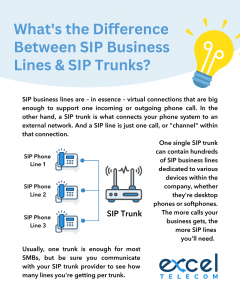If your business utilizes a VoIP phone system, chances are you’ve heard the term “SIP” mentioned by your communications provider or IT team. Maybe they’ve even talked about “SIP business line.” But what is SIP? Why are SIP business lines important? And what makes them different from SIP trunks? If you’re interested in the answers to these questions, just keep reading.
What is SIP?
Before we get started talking about SIP business lines, it’s important to know what SIP actually is. SIP stands for Session Initiation Protocol. It is an online signaling protocol that helps “set up” calls between two phones, allowing data to be transferred from one phone to another using another kind of protocol – RTP (Real-time Transport Protocol). Think of SIP as a virtual switchboard operator, talking to both parties to make sure they want to be connected before they connect them.
Thanks to its simplicity and flexibility, SIP can also set up video calls and other multimedia sessions between various devices such as smartphones, desktops, laptops, etc. Your VoIP phones all use some form of SIP to make and take calls.
What are SIP Business Lines?
SIP business lines are – in essence – virtual connections that are big enough to support one incoming or outgoing phone call. Often called “channels” or “sessions,” SIP business lines are what companies need to make and take calls over the internet and can consume various amounts of bandwidth. For example, if your business receives 300 concurrent calls a day, you’ll need approximately 300 SIP business lines.
QUICK TIP: To avoid overpaying for your SIP business lines, be sure you’re familiar with how many calls your business receives in an average day, week, and month. From there, decide how many SIP business lines you need to handle your highest call volume and go from there.
What’s the Difference Between SIP Business Lines & SIP Trunks?
It’s difficult to know the difference sometimes – especially if the terms are used interchangeably.
But they shouldn’t be. Because a SIP trunk is what connects your phone system to an external network. And a SIP line is just one call, or “channel” within that connection.
An easy way to remember the difference is to think of a SIP trunk as a highway and SIP business lines as its lanes. Each lane allows vehicles, which in this case represent packets of important data, to flow freely between two points. The more lanes you have, the more traffic you can handle!
One single SIP trunk can contain hundreds of SIP business lines dedicated to various devices within the company, whether they’re desktop phones or softphones. The more calls your business gets, the more SIP lines you’ll need. Usually, one trunk is enough for most SMBs, but be sure you communicate with your SIP trunk provider to see how many lines you’re getting per trunk.
SIP Business Lines: Why They’re Necessary
SIP business lines are necessary for a wide variety of reasons. Yes, SIP trunks establish the connection between your cloud PBX system and your VoIP service provider. But SIP business lines allow you to make and take voice and video calls using that connection. SIP business line also provide multiple benefits for businesses, like:
- Reduced the cost for long-distance and international calls
- Quick-and-easy scalability based on employee and customer needs
- Higher quality audio and visual calls
- Simplified network management
- Built-in disaster recovery with automatic call routing and redundancy
If you like the sound of those benefits, then SIP business line are going to be a great fit for your business.
Excel Telecom: A Leader in SIP Business Lines
If you’re interested in any of these benefits, our team at Excel Telecom is ready to help! Our SIP services are closely monitored and maintained, and are capable of providing the capacity you need to connect your employees and support your customers. Plus, we’ll manage your SIP deployment ourselves from start to finish, providing top-notch technical support even after the project’s complete. So, what’re you waiting for? Reach out to us today!

